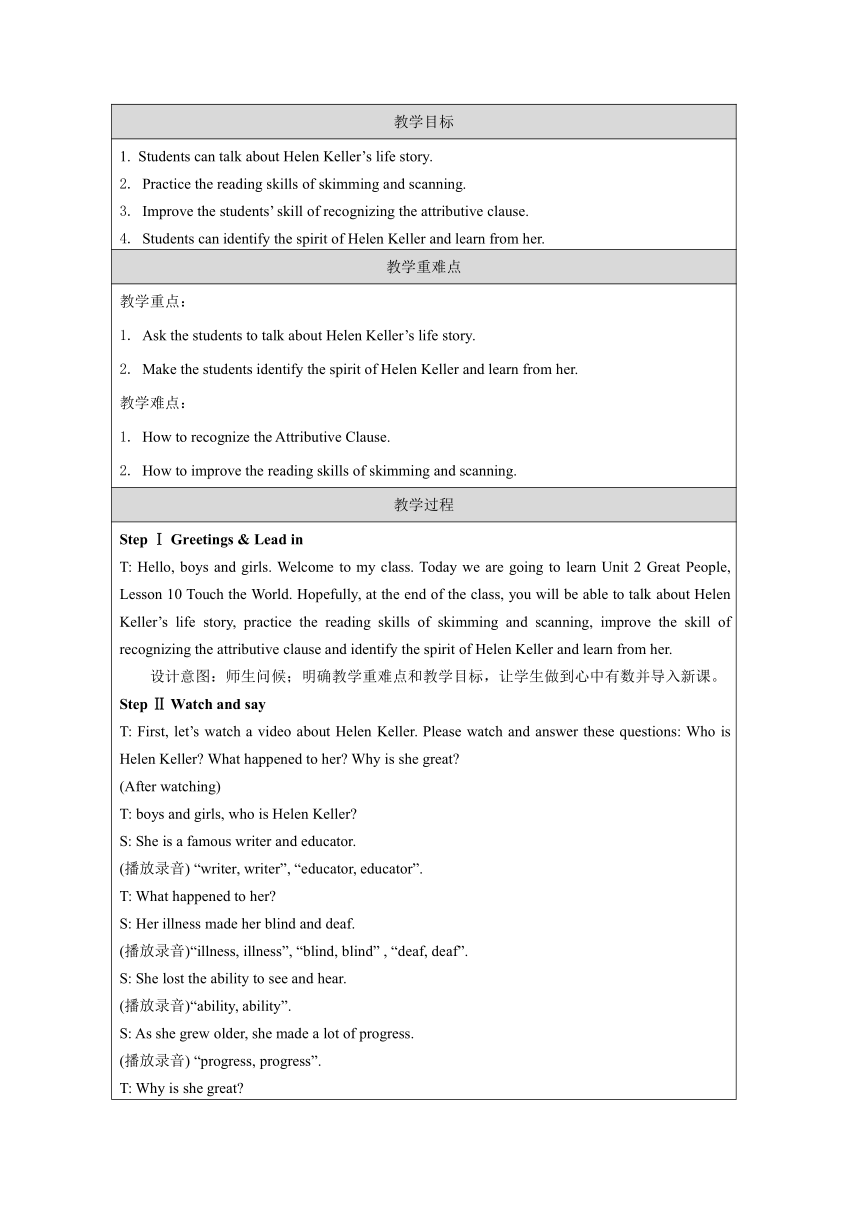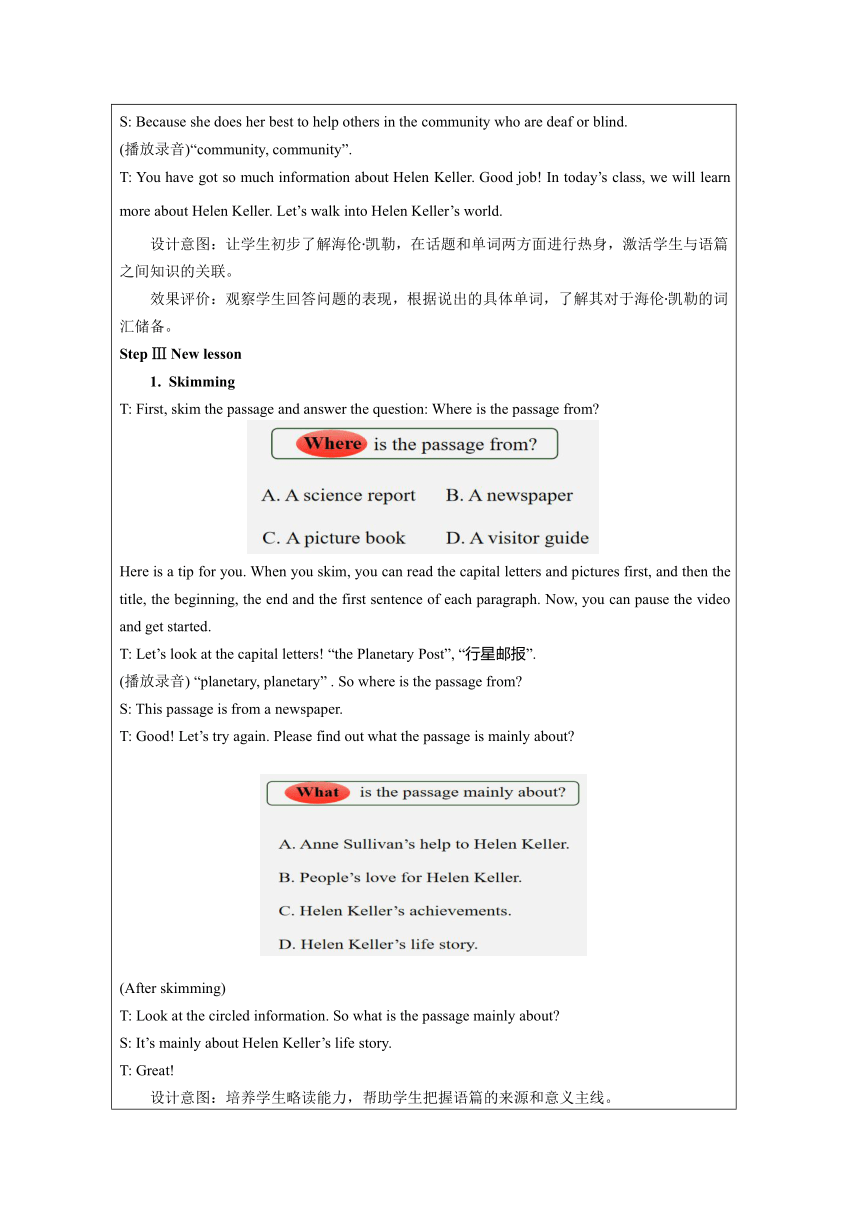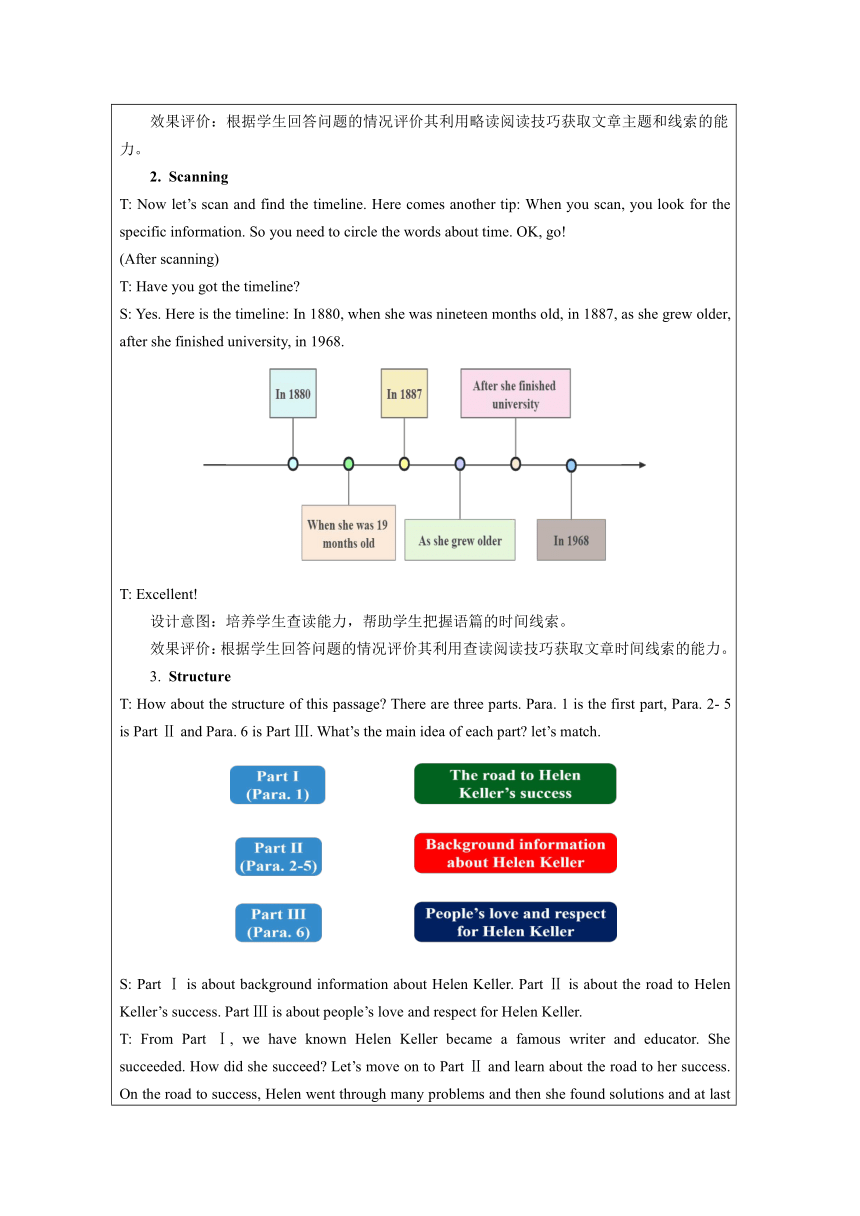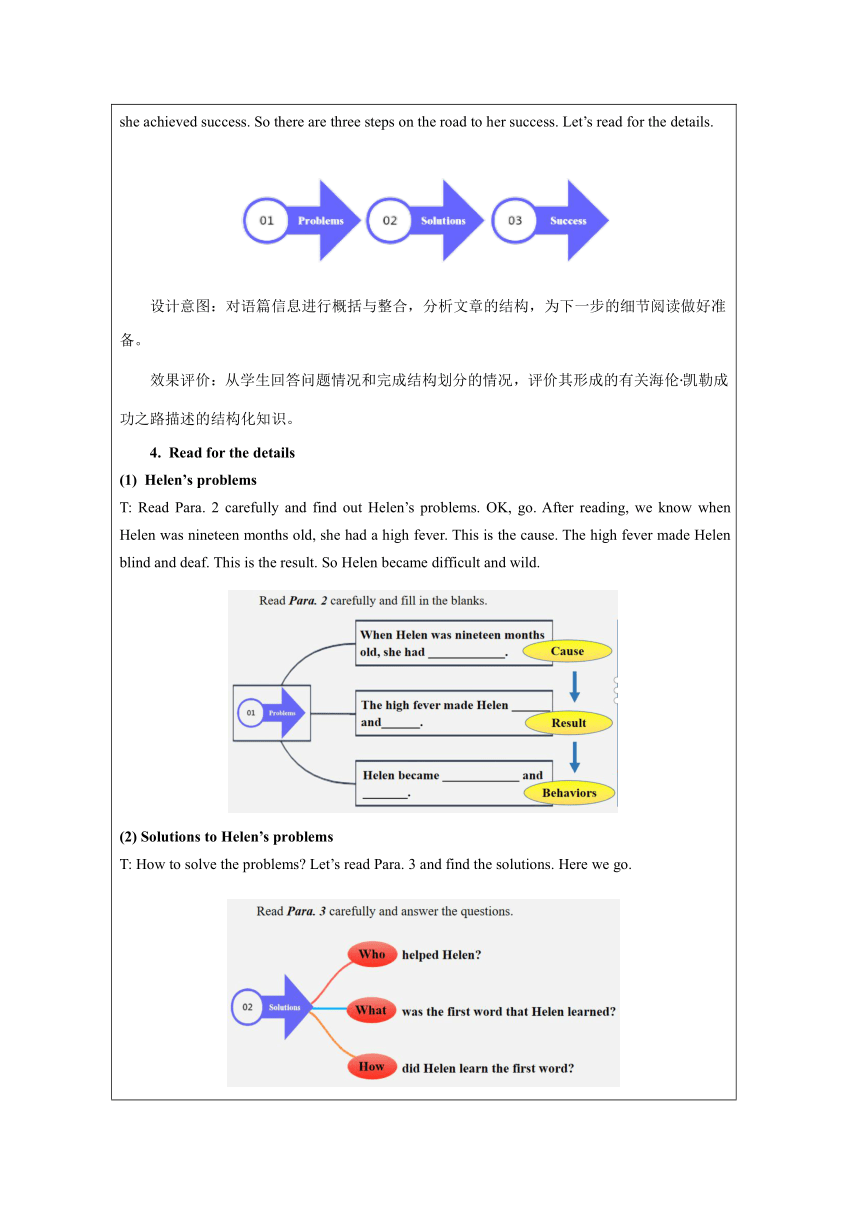Unit 2 Lesson 10 Touch the World教学设计(表格式)冀教版英语九年级全册
文档属性
| 名称 | Unit 2 Lesson 10 Touch the World教学设计(表格式)冀教版英语九年级全册 |  | |
| 格式 | docx | ||
| 文件大小 | 1.7MB | ||
| 资源类型 | 教案 | ||
| 版本资源 | 冀教版 | ||
| 科目 | 英语 | ||
| 更新时间 | 2024-08-25 11:19:30 | ||
图片预览





文档简介
教学设计
课程基本信息
学科 英语 年级 九年级 学期 秋季
课题 Unit 2 Great People Lesson10 Touch the World
教科书 书 名:英语教材 出版社:河北教育出版社
语篇研读
本课主题属于“人与社会”范畴,涉及“对世界、国家、人民和社会进步有突出贡献的人物”。 What:本课语篇介绍了著名的作家和教育家海伦·凯勒的生平和主要事迹。主要描述了她的成功之路以及她对世界人民的突出贡献。她永不放弃的精神、惊人的毅力、坚定的信念以及对待生活的态度赢得了大家的尊重和爱戴,为人类谱写了不屈不挠、努力抗争的伟大精神力量,成为众多残疾人甚至普通人的励志典范,她是世界人民的楷模。 Why:作者通过描述海伦·凯勒由于幼时发高烧导致失明和失聪,进而遇到的各种困难及解决办法,让学生认识到,要想克服困难取得成功,必须具备优秀的个人品质(永不放弃的精神、惊人的毅力、坚定的信念等),引发学生对人生意义的思考。 How:语篇体现了人物传记类文章的主要特征。明线讲述了海伦·凯勒的一生;暗线则揭示了海伦·凯勒成功的根本原因。文章分为三部分:第一部分(第1段)介绍了海伦·凯勒的背景知识;第二部分(第2~5段)介绍了海伦·凯勒的成功之路,这是该语篇的主体部分;第三部分(最后一段)主要表达了人们对海伦·凯勒深深地怀念和尊敬。 本语篇按照时间顺序展开: in 1880, when she was nineteen months old, in 1887, as she grew older, after she finished university, in 1968, 通过时间线索实现了语篇衔接。语篇逻辑脉络清晰,便于学生推断、总结和概括信息,即克服困难、取得成功的主、客观因素。 另外,文中合理利用时态。语篇先用一般过去时描述海伦·凯勒的生平事迹,然后用一般将来时表达了人们将永远怀念海伦·凯勒。
教学目标
Students can talk about Helen Keller’s life story. Practice the reading skills of skimming and scanning. Improve the students’ skill of recognizing the attributive clause. Students can identify the spirit of Helen Keller and learn from her.
教学重难点
教学重点: 1. Ask the students to talk about Helen Keller’s life story.
2. Make the students identify the spirit of Helen Keller and learn from her.
教学难点: 1. How to recognize the Attributive Clause.
2. How to improve the reading skills of skimming and scanning.
教学过程
Step Ⅰ Greetings & Lead in T: Hello, boys and girls. Welcome to my class. Today we are going to learn Unit 2 Great People, Lesson 10 Touch the World. Hopefully, at the end of the class, you will be able to talk about Helen Keller’s life story, practice the reading skills of skimming and scanning, improve the skill of recognizing the attributive clause and identify the spirit of Helen Keller and learn from her. 设计意图:师生问候;明确教学重难点和教学目标,让学生做到心中有数并导入新课。 Step Ⅱ Watch and say T: First, let’s watch a video about Helen Keller. Please watch and answer these questions: Who is Helen Keller What happened to her Why is she great (After watching) T: boys and girls, who is Helen Keller S: She is a famous writer and educator. (播放录音) “writer, writer”, “educator, educator”. T: What happened to her S: Her illness made her blind and deaf. (播放录音)“illness, illness”, “blind, blind” , “deaf, deaf”. S: She lost the ability to see and hear. (播放录音)“ability, ability”. S: As she grew older, she made a lot of progress. (播放录音) “progress, progress”. T: Why is she great S: Because she does her best to help others in the community who are deaf or blind. (播放录音)“community, community”. T: You have got so much information about Helen Keller. Good job! In today’s class, we will learn more about Helen Keller. Let’s walk into Helen Keller’s world. 设计意图:让学生初步了解海伦·凯勒,在话题和单词两方面进行热身,激活学生与语篇之间知识的关联。 效果评价:观察学生回答问题的表现,根据说出的具体单词,了解其对于海伦·凯勒的词汇储备。 Step Ⅲ New lesson Skimming T: First, skim the passage and answer the question: Where is the passage from Here is a tip for you. When you skim, you can read the capital letters and pictures first, and then the title, the beginning, the end and the first sentence of each paragraph. Now, you can pause the video and get started. T: Let’s look at the capital letters! “the Planetary Post”, “行星邮报”. (播放录音) “planetary, planetary” . So where is the passage from S: This passage is from a newspaper. T: Good! Let’s try again. Please find out what the passage is mainly about (After skimming) T: Look at the circled information. So what is the passage mainly about S: It’s mainly about Helen Keller’s life story. T: Great! 设计意图:培养学生略读能力,帮助学生把握语篇的来源和意义主线。 效果评价:根据学生回答问题的情况评价其利用略读阅读技巧获取文章主题和线索的能力。 Scanning T: Now let’s scan and find the timeline. Here comes another tip: When you scan, you look for the specific information. So you need to circle the words about time. OK, go! (After scanning) T: Have you got the timeline S: Yes. Here is the timeline: In 1880, when she was nineteen months old, in 1887, as she grew older, after she finished university, in 1968. T: Excellent! 设计意图:培养学生查读能力,帮助学生把握语篇的时间线索。 效果评价:根据学生回答问题的情况评价其利用查读阅读技巧获取文章时间线索的能力。 Structure T: How about the structure of this passage There are three parts. Para. 1 is the first part, Para. 2- 5 is Part Ⅱ and Para. 6 is Part Ⅲ. What’s the main idea of each part let’s match. S: Part Ⅰ is about background information about Helen Keller. Part Ⅱ is about the road to Helen Keller’s success. Part Ⅲ is about people’s love and respect for Helen Keller. T: From Part Ⅰ, we have known Helen Keller became a famous writer and educator. She succeeded. How did she succeed Let’s move on to Part Ⅱ and learn about the road to her success. On the road to success, Helen went through many problems and then she found solutions and at last she achieved success. So there are three steps on the road to her success. Let’s read for the details. 设计意图:对语篇信息进行概括与整合,分析文章的结构,为下一步的细节阅读做好准备。 效果评价:从学生回答问题情况和完成结构划分的情况,评价其形成的有关海伦·凯勒成功之路描述的结构化知识。 Read for the details Helen’s problems T: Read Para. 2 carefully and find out Helen’s problems. OK, go. After reading, we know when Helen was nineteen months old, she had a high fever. This is the cause. The high fever made Helen blind and deaf. This is the result. So Helen became difficult and wild. (2) Solutions to Helen’s problems T: How to solve the problems Let’s read Para. 3 and find the solutions. Here we go. (After reading) T: So who helped Helen S: Anne Sullivan, her teacher. (Show a picture of Anne Sullivan) T: What was the first word that Helen learned S: It was “water”. T: How did Helen learn the first word S: One day, while Helen was playing in some water, Anne spelled W-A-T-E-R on Helen’s hand. Suddenly, Helen understood. T: Great! Now let’s think about this question: How would Helen Keller feel after learning the first word Please answer with the following expressions: I think Helen would feel... because... In my opinion, Helen would feel... because... S: I think Helen would feel excited and proud of herself because it was the first word she learned. S: In my opinion, Helen would feel confident and hopeful because she learned many more words later. (3) Helen’s success T: Really wonderful ideas. Following this breakthrough, Helen made a lot of progress and achieved success. Please read Para. 4 and 5 and then make a list of Helen’s success. OK, go! T: Let’s finish the list. 设计意图:获取、梳理细节信息,培养学生根据关键词进行寻读的能力及对信息进行分 析与推断判断的能力,帮助学生对文章有深入的理解。 效果评价:观察学生对篇章细节信息的梳理是否准确,要点是否清楚,评价其对信息的 分析、判断能力。 The Attributive Clause T: This is Helen. She did her best to help others in the community who were deaf or blind. Now look at this sentence, here, “others” is modified by “who were deaf or blind”, the “who” sentence works as an attribute, so it’s called the attributive clause. “others” is the antecedent. “who” is the relative pronoun. What does the sentence mean S: 她尽了最大的努力去帮助社区中的那些失聪或失明的人。 T: Well done! Usually, the antecedent is a noun or a pronoun. When it refers to people, we use “who” or “that” as the relative pronoun. when it refers to things, “which” or “that” is used. Here is a task for you. Please find out the other two attributive clauses in the passage and translate them. T: Let’s check. S: In this sentence, “a high fever” is the antecedent, “that” is the relative pronoun. “that made her blind and deaf.” is the attributive clause. Here is the Chinese meaning: 她发了一场使她失明和失聪的高烧。 S: In the second sentence: “letters” is the antecedent, “that” is the relative pronoun. “that” sentence is the attributive clause. This is the Chinese meaning: 她有一些能用手指触摸到字母的特殊的书。 T: Well done. 设计意图:帮助学生理解定语从句的含义并且能够识别由关系词who, which, that引导的定语从句。 效果评价:根据学生对定语从句的寻找和翻译,评价其理解语言的准确性。 6. Retell the text T: It’s time to recall Helen Keller’s life story. Please retell the passage with the help of the timeline and key words. Ready Go. S: In 1880, Helen Keller was born in the United States. When she was nineteen months old, a high fever made her blind and deaf. In 1887, with her teacher Anne Sullivan’s help, she learned many words. As she grew older, she made a lot of progress and finished university. After that, she visited many countries and spoke about her life. She did her best to help others. In 1968, she died at the age of 88. 设计意图:帮助学生再次梳理海伦·凯勒的生平,加深学生的印象,并为下一个环节的深入思考做好铺垫。 效果评价:观察学生复述海伦·凯勒故事时的相关语言表达,把握学生对重点语言表达的学习和内化情况。 Step Ⅳ Further thinking T: After learning this passage, let’s think about this question: What’s the writer’s purpose in writing the passage A. To explain why Helen Keller was ill. B. To praise a great teacher Anne Sullivan. C. To tell people about Helen Keller’s achievements. D. To introduce Helen Keller and encourage people to learn from her. You can pause the video and think about it. Got it S: D is right. T: You’re right. Good work! 设计意图:根据语篇表层结构的主线探究和深入理解作者的隐含信息,启发深度思考,探究深层意义,为下一个环节做好铺垫。 效果评价:观察学生回答问题的表现,根据其说出的答案了解其对于语篇的深入理解是否到位。 Step Ⅴ Speak your mind T: Helen Keller is really a great person. With her hard work, she achieved success at last. In your opinion, what makes Helen Keller’s success What can you learn from Helen Keller I interviewed a student, let’s listen to his idea first. (Play the video) 设计意图:以一个学生的观点作为示范,引发学生自己对海伦·凯勒成功的思考和由此得到的收获并学会分享自己的观点。 效果评价:观察学生在分享时能否准确表达自己的观点,了解其对语篇的掌握程度,根据需要给出必要的反馈和指导。 Step Ⅵ Watch and say T: That’s a wonderful idea. What about yours You can pause the video and speak your mind. Although Helen Keller was disabled, she tried her best to help other disabled people. She touched the world, and the people around the world were deeply touched by her. Here, I’d like to share a video with you. Please watch and answer the question. T: (After watching) These disabled people are the superhumans. Do you agree Do you still remember the sentence S: “Yes, I can”. T: Well done. On the road to success, there will be many difficulties. So the road to success is never straight, you just need to remember “Yes, I can”. Believe in yourself and be confident of yourself. 设计意图:以此短视频展示残疾人身残志坚,永不放弃的精神,鼓舞学生遇到问题不要退缩,要像视频中的这些残疾人一样阳光自信。 效果评价:观察学生能否准确捕捉到关键的句子,能否体会到视频背后的深层意义,根据需要给出必要的指导。 Step Ⅶ Summary T: It’s summary time now. In today’s class, we talked about Helen Keller’s life story. We practiced the reading skills of skimming and scanning. We also learned to recognize the attributive clause and identified the spirit of Helen Keller. 设计意图:总结本课所学内容,为自评环节做好铺垫。 效果评价:观察学生能否总结出本节课的所学内容,根据需要给出必要的指导。 Step Ⅷ Self-assessment T: Have you achieved your learning objectives You can pause the video and assess yourself with the checklist. 设计意图:检验学生本节课是否达成了学习目标。 效果评价:观察学生是否能够使用“自评表”进行自评以达到“以评促学”的目的。 Step Ⅸ Homework T: Don’t forget your homework. You need to finish Let’s Do It! Exercise ①②③. You can read one of Helen Keller’s books or finish Let’s Do It! Exercise ④. T: Thanks for listening. Have a nice day. Goodbye. 设计意图:巩固课堂所学知识,促进拓展应用,使课堂教学得到有效延伸,让学习过程更完整。
课程基本信息
学科 英语 年级 九年级 学期 秋季
课题 Unit 2 Great People Lesson10 Touch the World
教科书 书 名:英语教材 出版社:河北教育出版社
语篇研读
本课主题属于“人与社会”范畴,涉及“对世界、国家、人民和社会进步有突出贡献的人物”。 What:本课语篇介绍了著名的作家和教育家海伦·凯勒的生平和主要事迹。主要描述了她的成功之路以及她对世界人民的突出贡献。她永不放弃的精神、惊人的毅力、坚定的信念以及对待生活的态度赢得了大家的尊重和爱戴,为人类谱写了不屈不挠、努力抗争的伟大精神力量,成为众多残疾人甚至普通人的励志典范,她是世界人民的楷模。 Why:作者通过描述海伦·凯勒由于幼时发高烧导致失明和失聪,进而遇到的各种困难及解决办法,让学生认识到,要想克服困难取得成功,必须具备优秀的个人品质(永不放弃的精神、惊人的毅力、坚定的信念等),引发学生对人生意义的思考。 How:语篇体现了人物传记类文章的主要特征。明线讲述了海伦·凯勒的一生;暗线则揭示了海伦·凯勒成功的根本原因。文章分为三部分:第一部分(第1段)介绍了海伦·凯勒的背景知识;第二部分(第2~5段)介绍了海伦·凯勒的成功之路,这是该语篇的主体部分;第三部分(最后一段)主要表达了人们对海伦·凯勒深深地怀念和尊敬。 本语篇按照时间顺序展开: in 1880, when she was nineteen months old, in 1887, as she grew older, after she finished university, in 1968, 通过时间线索实现了语篇衔接。语篇逻辑脉络清晰,便于学生推断、总结和概括信息,即克服困难、取得成功的主、客观因素。 另外,文中合理利用时态。语篇先用一般过去时描述海伦·凯勒的生平事迹,然后用一般将来时表达了人们将永远怀念海伦·凯勒。
教学目标
Students can talk about Helen Keller’s life story. Practice the reading skills of skimming and scanning. Improve the students’ skill of recognizing the attributive clause. Students can identify the spirit of Helen Keller and learn from her.
教学重难点
教学重点: 1. Ask the students to talk about Helen Keller’s life story.
2. Make the students identify the spirit of Helen Keller and learn from her.
教学难点: 1. How to recognize the Attributive Clause.
2. How to improve the reading skills of skimming and scanning.
教学过程
Step Ⅰ Greetings & Lead in T: Hello, boys and girls. Welcome to my class. Today we are going to learn Unit 2 Great People, Lesson 10 Touch the World. Hopefully, at the end of the class, you will be able to talk about Helen Keller’s life story, practice the reading skills of skimming and scanning, improve the skill of recognizing the attributive clause and identify the spirit of Helen Keller and learn from her. 设计意图:师生问候;明确教学重难点和教学目标,让学生做到心中有数并导入新课。 Step Ⅱ Watch and say T: First, let’s watch a video about Helen Keller. Please watch and answer these questions: Who is Helen Keller What happened to her Why is she great (After watching) T: boys and girls, who is Helen Keller S: She is a famous writer and educator. (播放录音) “writer, writer”, “educator, educator”. T: What happened to her S: Her illness made her blind and deaf. (播放录音)“illness, illness”, “blind, blind” , “deaf, deaf”. S: She lost the ability to see and hear. (播放录音)“ability, ability”. S: As she grew older, she made a lot of progress. (播放录音) “progress, progress”. T: Why is she great S: Because she does her best to help others in the community who are deaf or blind. (播放录音)“community, community”. T: You have got so much information about Helen Keller. Good job! In today’s class, we will learn more about Helen Keller. Let’s walk into Helen Keller’s world. 设计意图:让学生初步了解海伦·凯勒,在话题和单词两方面进行热身,激活学生与语篇之间知识的关联。 效果评价:观察学生回答问题的表现,根据说出的具体单词,了解其对于海伦·凯勒的词汇储备。 Step Ⅲ New lesson Skimming T: First, skim the passage and answer the question: Where is the passage from Here is a tip for you. When you skim, you can read the capital letters and pictures first, and then the title, the beginning, the end and the first sentence of each paragraph. Now, you can pause the video and get started. T: Let’s look at the capital letters! “the Planetary Post”, “行星邮报”. (播放录音) “planetary, planetary” . So where is the passage from S: This passage is from a newspaper. T: Good! Let’s try again. Please find out what the passage is mainly about (After skimming) T: Look at the circled information. So what is the passage mainly about S: It’s mainly about Helen Keller’s life story. T: Great! 设计意图:培养学生略读能力,帮助学生把握语篇的来源和意义主线。 效果评价:根据学生回答问题的情况评价其利用略读阅读技巧获取文章主题和线索的能力。 Scanning T: Now let’s scan and find the timeline. Here comes another tip: When you scan, you look for the specific information. So you need to circle the words about time. OK, go! (After scanning) T: Have you got the timeline S: Yes. Here is the timeline: In 1880, when she was nineteen months old, in 1887, as she grew older, after she finished university, in 1968. T: Excellent! 设计意图:培养学生查读能力,帮助学生把握语篇的时间线索。 效果评价:根据学生回答问题的情况评价其利用查读阅读技巧获取文章时间线索的能力。 Structure T: How about the structure of this passage There are three parts. Para. 1 is the first part, Para. 2- 5 is Part Ⅱ and Para. 6 is Part Ⅲ. What’s the main idea of each part let’s match. S: Part Ⅰ is about background information about Helen Keller. Part Ⅱ is about the road to Helen Keller’s success. Part Ⅲ is about people’s love and respect for Helen Keller. T: From Part Ⅰ, we have known Helen Keller became a famous writer and educator. She succeeded. How did she succeed Let’s move on to Part Ⅱ and learn about the road to her success. On the road to success, Helen went through many problems and then she found solutions and at last she achieved success. So there are three steps on the road to her success. Let’s read for the details. 设计意图:对语篇信息进行概括与整合,分析文章的结构,为下一步的细节阅读做好准备。 效果评价:从学生回答问题情况和完成结构划分的情况,评价其形成的有关海伦·凯勒成功之路描述的结构化知识。 Read for the details Helen’s problems T: Read Para. 2 carefully and find out Helen’s problems. OK, go. After reading, we know when Helen was nineteen months old, she had a high fever. This is the cause. The high fever made Helen blind and deaf. This is the result. So Helen became difficult and wild. (2) Solutions to Helen’s problems T: How to solve the problems Let’s read Para. 3 and find the solutions. Here we go. (After reading) T: So who helped Helen S: Anne Sullivan, her teacher. (Show a picture of Anne Sullivan) T: What was the first word that Helen learned S: It was “water”. T: How did Helen learn the first word S: One day, while Helen was playing in some water, Anne spelled W-A-T-E-R on Helen’s hand. Suddenly, Helen understood. T: Great! Now let’s think about this question: How would Helen Keller feel after learning the first word Please answer with the following expressions: I think Helen would feel... because... In my opinion, Helen would feel... because... S: I think Helen would feel excited and proud of herself because it was the first word she learned. S: In my opinion, Helen would feel confident and hopeful because she learned many more words later. (3) Helen’s success T: Really wonderful ideas. Following this breakthrough, Helen made a lot of progress and achieved success. Please read Para. 4 and 5 and then make a list of Helen’s success. OK, go! T: Let’s finish the list. 设计意图:获取、梳理细节信息,培养学生根据关键词进行寻读的能力及对信息进行分 析与推断判断的能力,帮助学生对文章有深入的理解。 效果评价:观察学生对篇章细节信息的梳理是否准确,要点是否清楚,评价其对信息的 分析、判断能力。 The Attributive Clause T: This is Helen. She did her best to help others in the community who were deaf or blind. Now look at this sentence, here, “others” is modified by “who were deaf or blind”, the “who” sentence works as an attribute, so it’s called the attributive clause. “others” is the antecedent. “who” is the relative pronoun. What does the sentence mean S: 她尽了最大的努力去帮助社区中的那些失聪或失明的人。 T: Well done! Usually, the antecedent is a noun or a pronoun. When it refers to people, we use “who” or “that” as the relative pronoun. when it refers to things, “which” or “that” is used. Here is a task for you. Please find out the other two attributive clauses in the passage and translate them. T: Let’s check. S: In this sentence, “a high fever” is the antecedent, “that” is the relative pronoun. “that made her blind and deaf.” is the attributive clause. Here is the Chinese meaning: 她发了一场使她失明和失聪的高烧。 S: In the second sentence: “letters” is the antecedent, “that” is the relative pronoun. “that” sentence is the attributive clause. This is the Chinese meaning: 她有一些能用手指触摸到字母的特殊的书。 T: Well done. 设计意图:帮助学生理解定语从句的含义并且能够识别由关系词who, which, that引导的定语从句。 效果评价:根据学生对定语从句的寻找和翻译,评价其理解语言的准确性。 6. Retell the text T: It’s time to recall Helen Keller’s life story. Please retell the passage with the help of the timeline and key words. Ready Go. S: In 1880, Helen Keller was born in the United States. When she was nineteen months old, a high fever made her blind and deaf. In 1887, with her teacher Anne Sullivan’s help, she learned many words. As she grew older, she made a lot of progress and finished university. After that, she visited many countries and spoke about her life. She did her best to help others. In 1968, she died at the age of 88. 设计意图:帮助学生再次梳理海伦·凯勒的生平,加深学生的印象,并为下一个环节的深入思考做好铺垫。 效果评价:观察学生复述海伦·凯勒故事时的相关语言表达,把握学生对重点语言表达的学习和内化情况。 Step Ⅳ Further thinking T: After learning this passage, let’s think about this question: What’s the writer’s purpose in writing the passage A. To explain why Helen Keller was ill. B. To praise a great teacher Anne Sullivan. C. To tell people about Helen Keller’s achievements. D. To introduce Helen Keller and encourage people to learn from her. You can pause the video and think about it. Got it S: D is right. T: You’re right. Good work! 设计意图:根据语篇表层结构的主线探究和深入理解作者的隐含信息,启发深度思考,探究深层意义,为下一个环节做好铺垫。 效果评价:观察学生回答问题的表现,根据其说出的答案了解其对于语篇的深入理解是否到位。 Step Ⅴ Speak your mind T: Helen Keller is really a great person. With her hard work, she achieved success at last. In your opinion, what makes Helen Keller’s success What can you learn from Helen Keller I interviewed a student, let’s listen to his idea first. (Play the video) 设计意图:以一个学生的观点作为示范,引发学生自己对海伦·凯勒成功的思考和由此得到的收获并学会分享自己的观点。 效果评价:观察学生在分享时能否准确表达自己的观点,了解其对语篇的掌握程度,根据需要给出必要的反馈和指导。 Step Ⅵ Watch and say T: That’s a wonderful idea. What about yours You can pause the video and speak your mind. Although Helen Keller was disabled, she tried her best to help other disabled people. She touched the world, and the people around the world were deeply touched by her. Here, I’d like to share a video with you. Please watch and answer the question. T: (After watching) These disabled people are the superhumans. Do you agree Do you still remember the sentence S: “Yes, I can”. T: Well done. On the road to success, there will be many difficulties. So the road to success is never straight, you just need to remember “Yes, I can”. Believe in yourself and be confident of yourself. 设计意图:以此短视频展示残疾人身残志坚,永不放弃的精神,鼓舞学生遇到问题不要退缩,要像视频中的这些残疾人一样阳光自信。 效果评价:观察学生能否准确捕捉到关键的句子,能否体会到视频背后的深层意义,根据需要给出必要的指导。 Step Ⅶ Summary T: It’s summary time now. In today’s class, we talked about Helen Keller’s life story. We practiced the reading skills of skimming and scanning. We also learned to recognize the attributive clause and identified the spirit of Helen Keller. 设计意图:总结本课所学内容,为自评环节做好铺垫。 效果评价:观察学生能否总结出本节课的所学内容,根据需要给出必要的指导。 Step Ⅷ Self-assessment T: Have you achieved your learning objectives You can pause the video and assess yourself with the checklist. 设计意图:检验学生本节课是否达成了学习目标。 效果评价:观察学生是否能够使用“自评表”进行自评以达到“以评促学”的目的。 Step Ⅸ Homework T: Don’t forget your homework. You need to finish Let’s Do It! Exercise ①②③. You can read one of Helen Keller’s books or finish Let’s Do It! Exercise ④. T: Thanks for listening. Have a nice day. Goodbye. 设计意图:巩固课堂所学知识,促进拓展应用,使课堂教学得到有效延伸,让学习过程更完整。
同课章节目录
- Unit 1 Stay Healthy
- Lesson 1 What's Wrong,Danny?
- Lesson 2 A Visit to the Dentist
- Lesson 3 Good Food, Good Health
- Lesson 4 Don't Smoke, Please!
- Lesson 5 Jane's Lucky Life
- Lesson 6 Stay Away from the Hospital
- Unit Review
- Unit 2 Great People
- Lesson 7 What Is the Meaning of Lift?
- Lesson 8 A Universe of Thought
- Lesson 9 China's Most Famous "Farmer"
- Lesson 10 Touch the World
- Lesson 11 To China, with Love
- Lesson 12 Guess My Hero!
- Unit Review
- Unit 3 Safety
- Lesson 13 Be Careful,Danny!
- Lesson 14 Accidents Happen
- Lesson 15 My Helmet Saved My Life!
- Lesson 16 How Safe Is Your Home?
- Lesson 17 Staying Safe in an Earthquake
- Lesson 18 Never Catch a Dinosaur
- Unit Review
- Unit 4 Stories and poems
- Lesson 19 A Story or a Poem?
- Lesson 20 Say It in Five
- Lesson 21 The Fable of the Woodcutte
- Lesson 22 The Giant(Ⅰ)
- Lesson 23 The Giant(Ⅱ)
- Lesson 24 Writing a Poem
- Unit Review
- Unit 5 Look into Science
- Lesson 25 Let's Do an Experiment!
- Lesson 26 Keep the Candle Burning
- Lesson 27 Planet Danny
- Lesson 28 The Study of Living Things
- Lesson 29 DNA—The Story of You
- Lesson 30 Science Affects Us
- Unit Review
- Unit 6 Movies and Theate
- Lesson 31 A movie or a Play
- Lesson 32 Moving Pictures
- Lesson 33 The Fisherman and the Goldfish(Ⅰ)
- Lesson 34 The Fisherman and the Goldfish(Ⅱ)
- Lesson 35 Theatres Are Fun!
- Lesson 36 Making Plays Is Fun
- Unit Review
